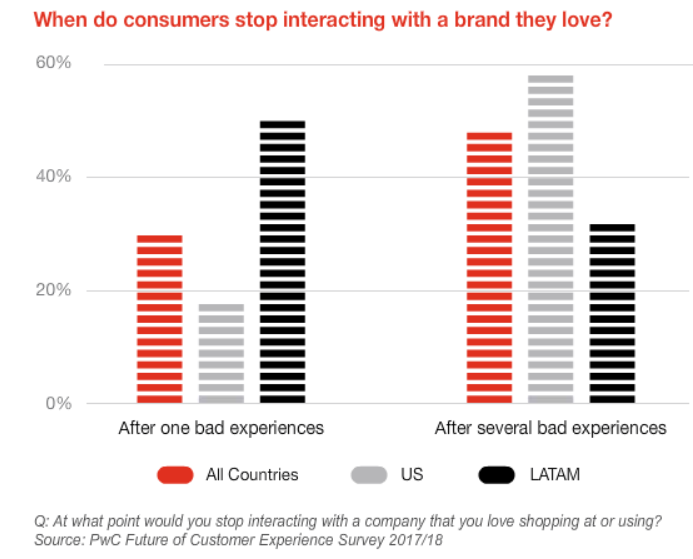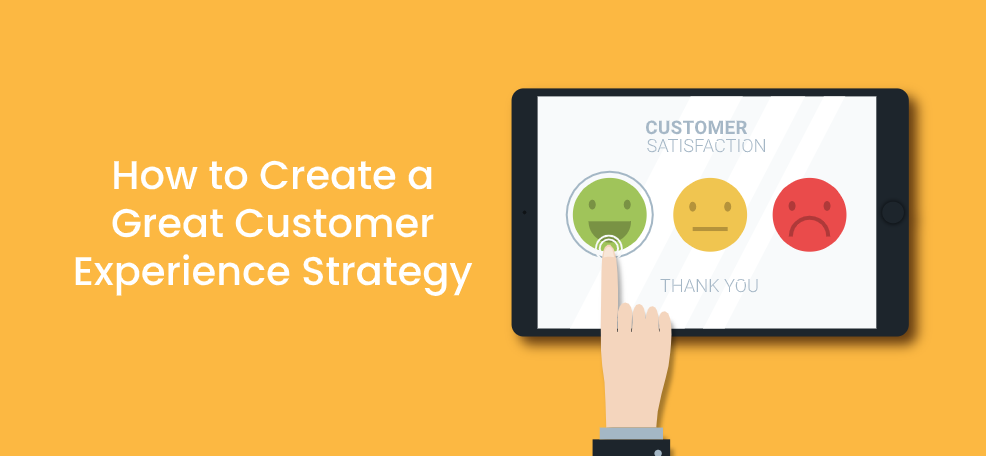Customer experience is central to any business’s success. Statistics show that the better experience you can deliver, the greater your customer retention will be.
A study conducted by Econsultancy and Adobe called the 2020 Digital Marketing Trends Report quizzed organizations on which was the most lucrative opportunity for them this year – and once again, most of them were unanimous in their answer of customer experience.
Customer experience is one of the determining factors of a brand’s destiny and establishes definitive customer loyalty. In fact, a study by Oracle revealed that 74% of business leaders say that customer experience impacts the loyalty of a customer. A single instance of poor customer experience could drive away almost 17% of customers, while repeated instances could lead to 59% of them churning and walking away from the product.

While gearing your company to make it a customer-centric business may be enough to motivate organizational change, you need to build initiatives and gather momentum first to achieve a unique customer experience that would help your product perform distinctively. This could also result in increased profit as research proves that 86% of customers will pay more for a great customer experience.
Building a great CX strategy is the start of ensuring a memorable experience for clients. It helps present novelty and enrich the customer experience. Here, we will wade through the elements of a successful customer experience strategy and see how to piece them together to build one.
1. Create a Clear Customer Experience Vision
The first step in building a customer experience strategy is delineating your customer experience vision. The simplest way to define it is to create a few statements that act as guiding principles for your CX strategy.
Be specific with your vision so that everyone in the organization can understand it easily. After creating a vision statement, enlist the collaboration of everyone in the company to invest their time and energy into making it a reality. Begin by introducing a customer-centric culture at the grassroots level to move the needle in the direction of improving the customer experience.
This alignment of company members will mean that all of them are geared towards the same vision so that each of them knows the part he/she has to play beforehand to make the vision a success. And lastly, to ensure that all employees are devoted to your customer-centric culture, you can set goals and tie them to incentives for certain customer outcomes.
2. Know Your Customers
Understanding customers and their needs thoroughly is an integral part of defining your customer experience strategy. Without knowing your customers beforehand and the situations they face, you will not be able to empathize with their woes and come up with alternatives or solutions to hold them, and your brand, in good stead.
It also bears mentioning that different pockets of customers will have different grievances. That’s why the first step in knowing your customers is to create accurate buyer personas. These buyer personas are profiles that represent a group of your customers that more likely than not face the same issues and have the same problems.
You can even conduct surveys to know different types of your customers and then utilize the data to build a CX strategy that addresses the pain points of all your customers. You can enable this process further by keeping track of the ads that your customers respond to gain a better insight into your customer’s minds.
Ensure that you maintain a record of the various personas and surveys you solicit information from to keep it handy whenever a certain department needs to refer to it. You can employ tools like HubSpot’s Make My Persona that help you create an attractive buyer persona and use other tools like Dropbox to store all your feedback surveys and other relevant details on it.

3. Enable Real-Time Support Capability
Did you know that businesses take an average of 12 hours and 10 minutes to respond to customer queries? This doesn’t even come close to meeting the soaring customer expectations of today. So how do you ensure to collect brownie points where most businesses fail to do so?
By facilitating real-time customer support.
Real-time customer support with the help of a live chat software can help you provide instantaneous solutions to customers and handhold them throughout the entirety of their customer journey if required.
Live chat can take customer support standards several notches higher by enabling your customer support team to engage with prospects in real-time during their customer journey.
You can also club live chat with a co-browsing software to help your support team interact with your customer’s screen readily to understand their grievances better and provide instant help by sharing the customer’s screen and guiding them through the product.
4. Make It Personal
After enabling real-time support, move on to personalizing the customer experience. Creating a customized experience can work wonders for your brand by increasing the loyalty of your customers. In fact, 80% of customers are more likely to purchase a service or a product from a business that provides personalized experiences.
Personalization helps brands differentiate themselves from competitors and foster a stronger relationship with customers. It is the nurturing of these relationships that result in customer loyalty down the line. And when done right, personalization signals to the customer that your brand is invested in their experience and wants to strengthen the relationship by working to provide enhanced service, better suggestions, instant support, among others.
A great personalization example is Brainshark, a B2B software provider. Brainshark was facing troubles converting free users to paying customers. That is when they employed the services of a third-party vendor to help them deliver personalized messages. After running some analytics on their product’s usage, they identified gaps in engagement and started with messages from inside the product interface and used ads and pop-ups on their website to communicate with existing users and provide them with tips on how to optimize Brainshark.

This eventually helped them increase registrations by 15% and realize a 150% growth on free trial sign-ups for their product. Their sales pipeline also registered a massive growth of over $1.1 million.
5. Collect Regular Feedback and Act Upon It
How do you know if you are delivering great customer experience? You ask your customers using tools like Canny. Feedback surveys have been a timeless companion of forward-thinking brands in that they help them optimize their offerings by listening to what customers have to say about them.
Collecting feedback regularly helps you measure customer loyalty and attrition. This feedback helps you learn more about the customer and how satisfied they are with your product.
Feedback in the form of testimonials and reviews can also act as a boon for your business. According to research by American Express, 34% of customers believe that positive word-of-mouth is much more important than a sale or promotion.
However, it doesn’t stop here. After soliciting feedback, it is necessary that you act upon it in a steadfast manner to enrich the customer experience even further. One of the best brand examples of using customer feedback to its advantage is Starbucks. The coffee company often engages with customers and asks for their opinions, thereby adding value to their customer experience.

Among their many initiatives to enrich CX, it is their “What’s your Starbucks idea?” program that stands out the most. By crowdsourcing feedback, the brand works upon suggestions, ideas, reviews, and more to collect valuable information on the three fronts of CX ideas, product ideas, and engagement ideas to diversify their product more. Apart from that, Starbucks also has a provision of letting customers chat with their representatives so that they can collect ideas from their customers and act on those that really matter.
6. Know Which Customer Experience Metrics to Track
Customer experience is an evolving standard and measuring customer satisfaction takes more than simply recording revenue growth or excess inventory. Since customer experience is so multi-faceted, it is only logical that deriving a comprehensive picture of it will require bench-marking it from various angles.
This is where customer experience metrics come in. You have to ask yourself which set of CX metrics help you paint a sweeping picture of the way customers feel about your brand. So, when it comes to measuring CX metrics, ensure to go after the following five to gain an expansive view of your CX picture.
Net Promoter Score (NPS): This score measures the likelihood of existing customers to recommend your brand to others. Customers rate their willingness to recommend you on a scale of 0 to 10. There are three scoring classes:
0-6: Detractors (those who won’t recommend you).
7-8: Passive customers (those who could easily switch).
9-10: Promoters (those who would recommend you).
Subtracting the percentage of detractors from promoters gives you your final NPS score.
Churn Rate: Churn rates help you measure the total percentage of consumers that leave your service after a certain period. It is determined by taking the difference of users at the beginning of a period and the users at the end of the period and then dividing the difference by users at the beginning of the period.
Customer Satisfaction Score (CSAT): Customer satisfaction score is measured on a five-point scale. These scores are usually measured after the end of customer service interactions.
Customer Effort Score (CES): A twist on CSAT, the CES score measures the effort of customers and rates their experience on a scale from very easy to very difficult. In other words, it asks customers how easy or difficult they found to use your product or service.
Customer Lifetime Value (CLV): The CLV is the predicted gross profit that is derived from a customer across the lifetime of the customer relationship.
These metrics will help you derive a panoramic view of your CX landscape. However, keep in mind to consistently evaluate the aforementioned metrics from multiple angles and accommodate the necessary changes in time to build an effective CX strategy.
Conclusion
A business’s customer experience strategy is its Rome — it can’t be built in a day. It is a slow process that requires you to define each step of it and work on defining and streamlining the six key areas above but do so under the notion that things are subject to change.
As you learn about what it means to communicate with customers on their terms and collect data along the way, you’ll find it’s easier to make informed decisions about your overall customer experience strategy.
About the author:
 Savan Kharod
Savan Kharod
He is a Digital Marketing Professional at Acquire. He loves to share his knowledge and experience in digital marketing, social media marketing, customer service and growth marketing. In his free time, Savan likes to backpack and explore new places.




